Early History
The Livonians speak a language closely related to Finnish and Estonian, and more distantly to Hungarian. It is a member of the Finno-Ugrian family of languages, which along with the Samoyedic languages forms the Uralic language family that stretches from Scandinavia east across northern Siberia and south to central Europe where Hungarian is spoken.
Initially, the name “Livonia” specifically referred to the land inhabited by the Livonian people. It first appears as such in an 11th Century Runic inscription in Sweden. In the 12th Century the Livonian people are mentioned in the Chronicle of Nestor, where they are referred to as lib’ or lyub’, and are given as a nation paying tribute to Russia. By the turn of the 13th Century, the arrival of German traders and missionaries in the Livonian lands, also marked the beginning of the early recorded history of the Livonian people (Karma 1995:76). The most famous record would become the Livonian Chronicle of Henry. Covering the time period from the eighth decade of the 11th Century till the year 1227, it records the conquest of the Baltic and Livonian lands by the Germans and Teutonic Knights.
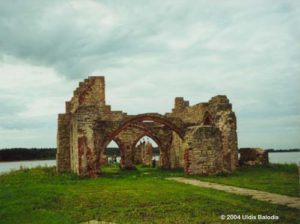
As inhabitants of the coast, the Livonians were among the first to encounter any foreigners arriving by sea. By the end of the 12th Century German missionaries and traders had begun flowing into the Livonian lands. Around 1164 the monk Meinhard arrived with a group of traders. He worked as both the confessor and accountant of this group, and soon after his arrival learned Livonian and began seeking converts among the Livonians he encountered. Meinhard had the first church built in Livonia, in the town of Üksküla (Latvian Ikšķile; modern Livonian Ikš kilā, meaning „one town“), and in 1186 he was made the first bishop of Livonia. (See Figures 1 and 2)
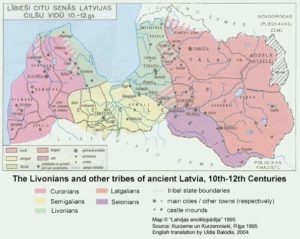
By the time he died in 1196, Meinhard had made only limited progress in his missionary work. Few Livonians had been converted to Christianity, and it became clear to Rome that other means would be necessary to accelerate their conversion. In 1199, Pope Innocent III announced a Northern Crusade in Livonia to convert the Livonians, Balts, and Estonians to Christianity. In 1202, Innocent created the Order of the Teutonic Knights (Fratres militie Christi de Livonia) that would be responsible for much of the forced conversion, and ultimately, subjugation, of the indigenous tribes of the region (Balodis 1991:29–30).
By the middle of the 13th Century, a new Livonia was being created. This would become the second geographic entity that would be known under this name. This Livonia, however, came to include land not inhabited by the Livonians themselves. By the end of the 13th Century it had become a confederation of what effectively were five feudal states (four bishoprics and the land administered by the Teutonic Knights). Declared by Pope Innocent III to be St. Mary’s Land (Terra Mariana, Terra Matris, or Terra beate Virginis), this Livonia covered much the same territory as present-day Latvia and Estonia (Balodis 1991:32). (See Figure 3)
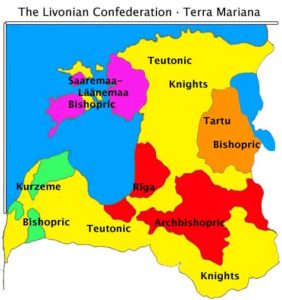
As the primarily German ruling class continued to consolidate its power and control over Livonia, the Baltic and Finnic tribes, and especially their languages, were left increasingly marginalized. Not only Livonian, but also the other indigenous Baltic languages, came to be excluded from meaningful contexts outside of daily interaction among speakers themselves. It was also at this time that the Livonians began to be pushed back, and their lands began to decrease in area. A trend that, once begun, would continue well into the twentieth century. Finally, with the consolidation of foreign power and establishment of at least the outward trappings of the Christian religion in the Baltic area, the Livonians themselves would disappear from the historical record for the next three centuries. Little is known about the specifics of their situation, but it is known that they did not take easily to the imposition of foreign religion and power in their land. (Vääri 1994:228) They would struggle against both, and thus come to experience further repression and attempts to weaken their will by the foreign ruling class.
One Livonia falls, another is created
The Livonian Confederation lasted until the middle of sixteenth century, when feuding among the statelets of the Confederation was utilized by the Russian Empire to its advantage. In 1558, the Russians crossed the Livonian border in the north and took Narva and Tartu (located in the eastern part of present-day Estonia). The Confederation was caught completely off guard by this invasion. The states scrambled to mobilize forces they did not have and to arm the Livonian and Latvian peasants. The peasants had long since become subjects, no better than indentured servants or serfs to the primarily German landowners. They had not been allowed weapons for quite some time, and many had no knowledge of how to use them. In other cases, the landowners balked at the thought of arming their peasant subjects, for the fear that the non-German peasants would turn against the landowners themselves.
As a result, the Russian forces swept through Livonia, and after a final battle in 1560, many towns and fortifications were surrendered to the Russians without a fight. Though the Confederation was finished, in 1559 its leaders had made a defense agreement with Poland-Lithuania. The Polish-Lithuanian forces routed the Russians in Livonia and took the entire region, with the exception of Tartu. In 1561, the lands constituting what had been the Livonian Confederation, largely came under the control of Poland-Lithuania. The northernmost part of the territory, the northern half of modern-day Estonia, ultimately came under Swedish rule, while the large Estonian island of Saaremaa came under Danish control. Kurzeme and Zemgale were formed into a duchy that became a subject state of Poland-Lithuania. (Balodis 1991:70–2)
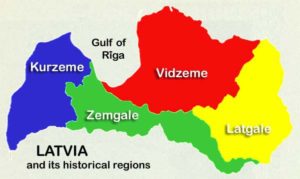
Along with these changes, the term Livonia too took on a new meaning, with the formation of a territory consisting of Vidzeme, Latgale, and the southern half of present-day Estonia (See Figure 4 for a map of the historical regions of Latvia referred to in this section). This territory was to be administered jointly by Poland and Lithuania. As with the Livonian confederation, this Livonia was also not connected in any particular way with the Livonian people. Now the Livonians were divided between two different jurisdictions. The Livonians living in Vidzeme on the eastern shore of the Gulf of Rīga were living in the province of Livonia, while those living on the western shore of the gulf, in Kurzeme, had come under the jurisdiction of the Duchy of Courland (Kurzeme). However, practically speaking not much had changed for the Livonians or the Baltic tribes that had by this time begun to coalesce into the Latvian people. Those in power were still largely the unassimilated descendants of the original German landowners and missionaries of centuries past, and German was still the language used for official functions.
Wars and changing hands
The 16th Century was a complicated time for what had been the Livonian Confederation. On one hand, the establishment of Polish-Lithuanian control over the area saw some improvement in the status of the Latvian language, though not the Livonian language. Jesuit monks in Vilnius had translated and published the Catholic Catechism in Latvian, and had increased the educational opportunities of non-German children in Rīga, by opening a boarding school providing free education. On the other hand, the division of Livonia would come to foster instability in the region (Balodis 1991:76).
After failed attempts to unify the Kingdoms of Sweden and Poland-Lithuania, war erupted between the two states in 1600. This war, lasting until 1629, was largely fought in Livonia, decimating the territory. As a result, the Livonian and Latvian peasant population decreased dramatically. In 1629, the borders and definition of Livonia would change one last time, with the cession of Vidzeme and the southern part of present-day Estonia to Sweden. Latgale was left to the Poles, who would come to call it Inflantia, the Polish term for Livonia. (Balodis 1991:79, 82) (See Figure 5)
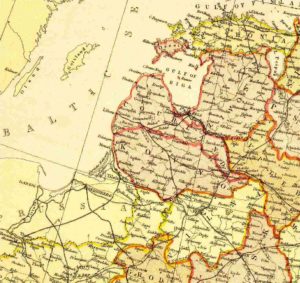
During the Swedish period, the lives of peasants would not become significantly easier. Though they had been given a certain amount of legal recourse and rights, by this time the movement and freedom of peasants had been severely restricted as they had come to be legally bound to the manor and land they worked. The situation was not better in the Duchy of Courland (Kurzeme), where the peasants effectively had no rights at all, and were bound not only to the land that they worked, but also were entirely under the jurisdiction and control of their landowners (Balodis 83–87, 102–3).
The same time period also saw the reemergence of the Livonians in the historical record. In the Chronica der Prouintz Lyfflandt of Balthasar Rusow, we read only that by the beginning of the sixteenth century there remained only very few Livonians in their traditional lands. Similarly, in the Ehst-, Lyf-, und Lettlaendische Geschichte of Thomas Hiärne, we read that during the same time period, the few Livonians still remaining in Vidzeme, were located primarily near Salaca, Limbaži, and Liepupe. Hiärne, also writes that there were more Livonians remaining in Kurzeme than in Vidzeme. Already three centuries prior to their disappearance, we can see the differences developing between the these two communities. While Hiärne says that the Livonian communities in Kurzeme were still on the whole exclusively Livonian, the Vidzeme Livonians were already living in communities mixed with Latvians. A fact that would certainly contribute to their eventual assimilation by the end of the nineteenth century. (Vääri 1994:228–9)
Russian Rule
With the Swedish victory in its war against Poland-Lithuania, the other great powers of Europe felt threatened. War erupted once more in the Baltics, this time between Sweden and Russia. Russia would be the victor in this conflict, and in 1710 took the province of Livonia as its prize. By the end of the eighteenth century the lands of the Duchy of Courland (Kurzeme) too had been absorbed by Russia. The situation of the peasantry reached its lowest level yet. Under the new order, the rights and privileges of the German landowning class were protected, while the rights of the Latvian and Livonian peasants were rendered effectively non-existent. Laws binding peasants to the manors and adjoining lands that they worked, also limiting their right to free movement, were harshly enforced. Without any fear of legal repercussions, the German landowners could resort to punishments including maiming and execution of peasants that would attempt escape from their bondage. The non-German peasant classes had effectively become slaves in their own land. Restrictions on the free movement of peasants would continue to stay in effect for nearly another century, being lifted only in 1804. (Balodis 1991:110–3, 117)
During the course of the eighteenth and nineteenth centuries, the Livonian population in both Kurzeme and Vidzeme continued to dwindle. This was aided by an epidemic of bubonic plague that ravaged the towns and countryside. In northern Kurzeme, the Livonians were rendered practically extinct, with a population of 1600 on the coast being reduced to 10. Miraculously, by the middle of the nineteenth century the number of Livonians living in northern Kurzeme had returned to about 2000.
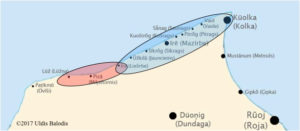
The Livonians living on the northern coast of Kurzeme were divided between two different tracts of manor land. This fact led to the emergence of the western and eastern dialects of Kurzeme Livonian (See Figure 6). Due to the fact that laws limiting the free movement of peasants prevented the peasants from the two manors interacting as much as they would perhaps otherwise, the Livonian spoken in each area began to take on unique characteristics. The western dialect of Kurzeme Livonian would come to be spoken in Pizā (Miķeļtornis) and Lūž (Lūžņa), with a transitional dialect being spoken in Īra (Lielirbe), and the eastern dialect being spoken in the remaining towns to the east (Karma 1995:77). Both dialects would remain mutually intelligible, though the eastern dialect would eventually come to form the basis of the Livonian literary language in the late twentieth century.
In Vidzeme, the situation of the language was arguably worse than in Kurzeme. Traditional beliefs had persisted among both the Latvians and Livonians. Though both nations had been officially Christianized, in many ways Christianity was still a foreign religion. Much of the clergy did not speak Latvian or Livonian, and were largely motivated by worldly pursuits rather than spiritual ones. In addition, the clergy were often in league with the landowners, aiding in the oppression of the peasants. (Balodis 1991:113)
Well into the eighteenth century, there are reports of the Christian clergy in Vidzeme not only condemning traditional spiritual practices, which perhaps would not be that surprising, but also actively working to eradicate traditional practices with actions such as cutting down trees in Livonian sacred groves. To further break the will of the Vidzeme Livonians, the clergy also advocated a policy of forbidding the Livonians from speaking to each other or teaching their children Livonian. The mainly German landowners broke up communities of Livonian speakers, by moving Livonian families and scattering them among the far more numerous Latvian-speaking peasants. This did much to accelerate the assimilation of the Vidzeme Livonians. So much so that by the beginning of the second half of the nineteenth century, the Livonian language in the region was moribund and on the verge of extinction (Karma 1995:77).
The First National Awakening
The arrival of foreign invaders in the Livonian lands six centuries earlier, had brought the Livonian people nothing but destruction and humiliation. Where they still lived, they had been made servants in their own land, and their language, once one of the major languages of the Baltic area, had been eliminated from all spheres of public life, leading to what appeared as an accelerating march towards extinction. So it is somewhat of a historical irony that a new breed of outsider would plant the seed for the rebirth of the nation’s self-awareness.
In the case of the Livonians, Latvians, and other European nations that had not known the existence of their own modern state or had been marginalized from influential positions in their society by a foreign power, a national awakening could mean many things. It usually would involve a realization that the culture and language of the group was not in any way inferior or less interesting than that of an outside culture or language present in the same society. After often being told of the inherent inferiority of their language and way of life, these nations could take pride in what was their own. In some cases the result was the creation of a national literature, or in the case of many Northern European nations, national epics (Finnish Kalevala, Latvian Lāčplēsis, etc.) that in some way also extolled the heroic past of the people. Often this would lead to the establishment of a nationalistically-minded intelligentsia and the formation of an independent state, as it did for the Latvians, Lithuanians, and Estonians, at the beginning of the twentieth century.
For the Livonians, their first great national awakening began as a result of the linguistic work that was done on their language in the middle of the nineteenth century. Already at the end of the eighteenth century, the similarities and likely relationship between Estonian, Finnish, and Livonian, had been noted by A.V. Hupel in his Topografische Nachrichten. (Vääri 1994:230) In 1846, Finnish linguist Andreas Johan Sjögren visited the Livonian communities in both Vidzeme and Kurzeme. He would return to Kurzeme in 1852 to continue his research. At the time he recorded the presence of 724 speakers of the western dialect and 1600 speakers of the eastern dialect, for a total of a 2324 speakers of Livonian in Kurzeme. (Vääri 1994:233) After his death, his work was continued by Ferdinand Johann Wiedemann, an Estonian researcher from Tallinn, capital of present-day Estonia. Wiedemann visited the Kurzeme Livonians in 1858, publishing Livische Grammatik nebst Sprachproben under both linguists’ names in 1861 (Karma 1995: 78).
Wiedemann and Sjögren’s work would become the first great linguistic work on Livonian. Even today, a century and a half after it was first published, the depth of the scholarship provides a truly fascinating resource for those interested in Livonian. While Sjögren primarily lists examples of Livonian collected on his journeys to Kurzeme and Vidzeme, Wiedemann adds a fascinating hundred page long introduction that discusses the history of the Livonian people, as well as, their culture and traditions, along with a detailed analysis of the grammar of Kurzeme Livonian. Due to the fact that by this time Vidzeme Livonian was nearly extinct, Sjögren and Wiedemann’s collaboration provides one of the very few records of the Vidzeme dialect of Livonian.
The arrival of the linguists on the Livonian coast in Northern Kurzeme ultimately led to the publishing of the first non-linguistic texts in Livonian. Compared to the other major languages of Europe, the languages of the Baltic area came to be written relatively late. The first texts in Latvian appeared only in the sixteenth century, with texts in Livonian only appearing in the middle of the nineteenth century. Earlier small collections of recorded words had appeared, primarily collected by travelers and authors of the earlier chronicles. These collections stretch back to the aforementioned Chronicle of Henry, with the phrase maga magamas (difficult to translate, literally “sleep sleeping”) appearing as the first example of Livonian mentioned in the historical record. However, all of these collections of words did nothing to elevate the literary level of the speakers of Livonian themselves, more so they were seen as curiosities and items of interest intended for outsiders.
In their work with the Livonians of Northern Kurzeme, the linguists encouraged and assisted their main informants in translating the Gospel of Matthew into Livonian. The gospel was translated into the eastern dialect by Nika Polmanis (1823–1903), and into the western dialect by Jāņ Prints Sr. (1796–1868) and his sons Jāņ Prints Jr. (1821–1904) and Pētõr Prints (1831–1889). To this day, the Prints or Prince family is known as one of the more famous Livonian families that helped lay the groundwork for the future evolution of literary Livonian.
Polmanis, as well as, Prints Sr. and his sons, were primarily of a religious or educational vocation. Polmanis had been a teacher in Kuoštrõg (Košrags) and a sacristan in Kūolka (Kolka). Similarly, Prints Sr. was a sacristan in Pizā (Miķeļtornis). His sons Pētõr and Jāņ Jr. were a local teacher and town elder, respectively. The publication of the translations was complicated by a peasant uprising among the Livonians in 1859 and 1860 in the town of Dundaga in Northern Kurzeme. As a result, the landowners would evict many of the Livonians from their homes and rent out their land to more obedient non-Livonian peasants from further inland. (Karma 1995:78)
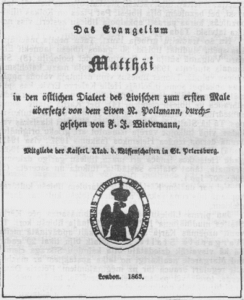
In 1863, two years following the publication of Livische Grammatik, Wiedemann had found a willing publisher, a British Bible publishing house in London. The books were published the same year. Polmanis’ translation into the eastern dialect appeared as Das Evangelium Matthäi in den östlichen Dialect des Livischen zum ersten Male übersetzt von dem Liven N. Pollmann. The translation by the Prints’ family into the western dialect appeared as Das Evangelium Matthäi in den westlichen Dialect des Livischen übersetzt von dem Liven J. Prinz und dessen Söhnen P. Prinz und J.P. Prinz. (Vääri 1994:234) (See Figure 7)
In the following decades, there would be a limited output of written Livonian. Still, outside circumstances once again came to intervene in the Livonians’ attempts to build their own nation and cultivate their national sense of self. With the arrival of the first decades of the twentieth century along with the tumultuous years of World War I, the Livonians once again were scattered, their homeland ravaged by another conflict. But this time the groundwork had been laid, and in the years following this war, more would be accomplished than ever before to create a modern Livonian nation.
The Second National Awakening
With the end of World War I and the establishment of the Republic of Latvia in 1918, the stage was set for a dramatic improvement in the conditions and use of the Livonian language in its traditional home on the northern coast of Kurzeme. At the beginning of the twentieth century there still remained a fairly concentrated population of Livonian speakers inhabiting 12 small towns in Northern Kurzeme. The towns were somewhat isolated from the rest of Kurzeme by a belt of uninhabited forests and swamps, which allowed the Livonian identity of the area to be preserved. Soon after the end of the war, in the early 1920s, a new generation of linguists began arriving on the Livonian Coast. The two most notable researchers of this group were Finnish linguist Lauri Kettunen (1885–1963) and Estonian ethnographer Oskar Loorits (1900–1961). (Karma 1995:78) As Sjögren and Wiedemann before them, Kettunen and Loorits were interested in the Livonians not just as research subjects and linguistic informants, they also were concerned with improving the status and use of the Livonian language.
Soon after the establishment of the independent Latvian state a land reform enacted by the government between 1920 and 1924. Most of the German landowners were permitted to keep their family residence and approximately 50 ha of land. About 52% of the expropriated land became the property of the Latvian government, while the rest was divided among 144,681 farmers and landless peasants (Balodis 1991:209–210).
In truth, this applied most to the Latvians, who now had the chance to build their own state with their own language as its medium of communication. During the first independence period between 1918–1940, the Latvians composed approximately 75% of the population of the country. At about the same time, according to the 1935 state census, the Livonians composed 32% of the population of their coastal homeland (944 individuals out of 2746 total residents), stretching from Lūž to Mustānum. 29% of the population in these towns (790 individuals) still spoke Livonian, but only 215 individuals reported using their language at home. (Šuvcāne 2003:9)
There were provisions for minority language education in Latvia, extending mainly to the Russian, German, Polish, and other larger ethnic minorities in the country. But with the establishment of Latvian independence, no immediate move was made to set up Livonian language education in the towns where the language was still spoken. However, it is also true that there did not really exist any Livonian speakers who had been trained as primary or secondary school teachers, and certainly not any Latvian speakers who had been trained as schoolteachers and also spoke Livonian.
This and other issues needed to be resolved, and would lead to the establishment of Līvõd Īt (the Livonian Union, henceforth LĪ) on April 2, 1923. Initially, Līvõd Īt sought to not only provide Livonian language education for the schools in the coast towns, but also to unite all the Livonian towns within the boundaries of a single district (pagasts, in Latvian). In both cases the LĪ had difficulty working with the Latvian government to achieve its aims. Sadly, it seemed that though the Latvians themselves had only recently thrown off the yoke of foreign domination, this did not mean that the Latvian government was necessarily any more understanding or sympathetic to the yearning of the Livonian people to express and promote their own culture and language in their homeland. The idea for the creation of a Livonian national district was discussed by Latvian lawmakers in the Interior Ministry, but ultimately was refused. This refusal seemed to stem from a fear that the consolidation of the entire Livonian nation into a single district could ultimately lead to demands for some form of local sovereignty. (Vääri 1994:241)
Though unsuccessful in lobbying for the creation of a single Livonian district, the LĪ would have more luck in convincing the Latvian government to permit Livonian language classes in the coast schools. The government ultimately would give its permission to allow Livonian to be taught as an elective subject once a week. Having received permission to teach the language in the schools in their homeland, the Livonians were faced with another problem, namely that there were no trained teachers of Livonian, and no books for teaching the language. This situation and the unprecedented opportunity to have their own language taught in their own schools, called for an unusual solution. The teaching of Livonian in the coast schools was undertaken by the Livonian sailor Maŗt Lepst, who ended up riding on horseback from town to town, teaching at each school one day a week. (Karma 1995:78–9) Though the language instruction was still not of a level to where non-Livonian-speaking children could hope to learn Livonian at school, the teaching of the language in the coast schools raised the status of the language and also led to the production of teaching materials that helped establish and strengthen what would become the basis of the modern Livonian literary language and orthography.
Still, the Livonian Union knew that only one thing would ensure that the language could be taught at these schools on a consistent basis, and that would be actual Livonian speakers trained as teachers. With this thought in mind, the LĪ helped three Livonian young people, Pētõr Damberg (1909–1987), Hilda Grīva (later Cerbaha, 1910–1984), and Alīse Gūtmane, enroll in the Jelgava Teachers’ Institute, located in the southern Latvian city of Jelgava. Already before completing his course of study at the Institute, Damberg was invited to Finland in 1933 to prepare what would become his magnum opus and one of his most memorable contribution to the furthering of writing and education of Livonian, his Jemakīel Lugdõbrāntõz Skūol ja Kuod pierast (Mother tongue reading book for school and home, henceforth JLSK). The book, a collection of 91 short stories written in Livonian, was intended by Damberg not only as a reader for children studying Livonian at school, but also for home use (Karma 1994:127).
After completing their course of study, almost unbelievably, none of the three young teachers received teaching positions in their home district on the coast. Soon thereafter Pētõr Damberg would be required to report for his mandatory military service in the Latvian military, while the other two students were sent to teach elsewhere (Karma 1994:127–8).
When Damberg’s book, JLSK, was published in 1935, it was received with great acclaim. However, in order for it to be used in schools, it had to gain the approval of the Latvian Education Ministry. After many delays and much hesitation, the ministry denied approval to the book, as its content was said to “conflict with the life and idea of the Latvian state.” (Karma 1994:128) Following diplomatic appeals from Finland, a compromise was reached. The book could be used in schools, as long as it included a page at the end with a Latvian folk song, a short text on Latvian history, and the Latvian national anthem. Unfortunately, approval of the book came only shortly before the outbreak of World War II, so the useful life of the book in the Livonian schools was quite short (Karma 1994:128).
Still, any education at all in Livonian, remained one of the great achievements of the LĪ. In addition to sending the three Livonian young people to the Teachers’ Institute in Jelgava, the LĪ also sponsored other young Livonians who wished to study abroad in Estonia and Finland. It also did much to build ties between the Livonians and their linguistic relatives, the Estonians, Finns, and Hungarians. The 1920s and 1930s also saw a sizeable increase in publications in the Livonian language. Among these was a collection of Livonian poetry called Līvõd Lōlõd (Livonian Songs) by Kōrli Stalte, another Livonian cultural luminary of the time. During his life, Stalte was the editor of several Livonian publications, the author of a number of Livonian books. He taught Livonian in the village school in Īra (Lielirbe), and between 1937 and 1942, along with Livonian Edgar Volganski-Valgamā, translated the New Testament into Livonian. (Karma 1995:79) Stalte and his family would come to form another of the most important Livonian families, with his relatives continuing to be an active and influential force in Livonian cultural life to this day .
In 1931, the Livonian students from the Jelgava Teachers’ Institute, aided by Finnish financial support, began publishing “Līvli” (the Livonian), a monthly newspaper in Livonian. (Karma 1995:79) During the same year, Finnish pastor Helle Kalervo Erviö began to journey to the Livonian Coast several times a year to hold mass in Livonian. To have Livonian as the language of the church on the coast had long been a dream of Livonians working to raise the status of their language in their homeland. In time, Erviö learned Livonian, and came to the coast on a fairly regular basis until 1938 (Vääri 1994:241). Church services in Livonian, just as Livonian language instruction in the coast village schools, were to remain a relatively infrequent phenomenon. Still, they too could be viewed as a great achievement. At the close of the 1930s, the status of the Livonian language had reached unprecedented heights, achieving roles in the dynamic of the languages used by the residents of the Livonian Coast, that had not been seen in over seven centuries.
One final dream would be realized prior to the abrupt end to Latvian independence at the onset of World War II. Construction began on what would come to be known as the Livonian National Hall (Līvlist Rovkuoda), a center in the largest Livonian town, Irē (Mazirbe), that would serve as a focus for the Livonian people, their work and ambitions. It was hoped that it would come to be seen as a symbol of their nation, a nation that had come to be more clearly defined than ever before in the previous two decades, its status secured in ways not possible for the previous eight centuries. The Hall was officially opened on August 6, 1939.
But these achievements were to be short-lived. Within three weeks of the unveiling of the new Livonian Hall, unbeknownst to the Livonians or anybody else, the Soviet and Nazi governments had signed the secret Molotov-Ribbentrop Pact dividing Europe between the two powers. After some final negotiation between the Soviets and Germans, it was agreed that all of the Baltic countries were to come under the Soviet sphere of influence (Karma 1995: 79).
That same year the Baltic States were each forced to sign cooperation agreements with the Soviet Union, giving the Soviets the right to establish military bases on the territory of the three countries. (Balodis 1991:277–8) There was little the three small states could do, facing such an overwhelming power. The hope among the Baltic governments was that by lying low, hopefully the conflict would pass over them. The Finns who had been given a similar ultimatum by the Soviets, refused to sign the pact. As a result, they would be attacked by the Soviets anyway. However, because they did not succumb to the initial Soviet demands, the Finns had the chance to defend themselves before the Soviets had the opportunity to disarm the populace and overthrow their government, as they would do in each of the Baltic States. At the end of World War II, the Finns kept their independence, while the Baltics would lose theirs.
The Years of Soviet Domination
The arrival of World War II brought with it great destruction to the coast that had by now become the only homeland remaining for the Livonian people. By the summer of 1940, Latvian president Kārlis Ulmanis had been forced to appoint a government hand-picked by the Soviet authorities. One of the first orders of business for the new government was to organize and stage elections for a new “People’s Parliament” (Tautas Saeima, in Latvian). Only one political party was allowed to compete in these elections and it was composed solely of persons approved of by the puppet regime imposed on Latvia by the Soviet authorities. Shortly after the predictable outcome of these elections, the new parliament requested the admittance of Latvia to the Soviet Union as a constituent union republic. (Balodis 1991:281–5)
The new parliament was hardly representative of the true will or opinions of the citizens of Latvia, and its decision to petition and ultimately join the Soviet Union violated the Latvian constitution. The constitution stated that any international agreement or law adopted by parliament that alters the nature of the sovereignty of the Latvian state could only be enacted with the approval of a majority of the nation’s citizens through a national referendum. No poll was held, but nevertheless the request by the puppet parliament was gladly accepted by the Soviet government. As a result, the Republic of Latvia became the Latvian Soviet Socialist Republic on August 5, 1940. (Balodis 1991:286–7)
Initially, the new Soviet government tried to assure the residents of the Baltics that little would change. But these assurances soon showed themselves to be false. By the end of 1940, political repressions were well underway. Opponents of the Soviet regime who had fought for Latvian independence two decades earlier were being arrested and sent to labor camps in Russia. (Balodis 1991:293–5)
As for the Livonians, soon after the incorporation of Latvia into the Soviet Union, the National Hall in Irē (Mazirbe) was seized by the new Soviet government, the Livonian Union and other Livonian organizations were banned, publication of Livonian books was forbidden, as was the teaching of Livonian in schools. (Karma 1995:79) All that had been achieved in the previous decades was uprooted in a few short months, and sad to say this would only be the beginning.
In the following year, on the night of June 14, 1941, thousands of men, women, and children all over Latvia were arrested by Soviet authorities, loaded onto cattle cars, and deported to slave labor camps in Siberia (Balodis 1991:297–300). This was the beginning of a policy of ethnic cleansing that the Soviet government would continue to carry out in the Baltic States over the course of the next decade. The deportations affected the Livonians as much as the Latvians. Many of the innocent people taken from their homes on their ancestral coast that night would never return (Karma 1995: 79). Seen in the light of the centuries of German and Russian domination of the Baltics, as well as, the policies of the Soviet Union against other non-Russian nationalities in the previous decades, these repressions were hardly surprising. The ultimate goal, as it had been earlier, was the further weakening and assimilation of the nationalities indigenous to the Baltic area, in the process consolidating the power of the colonial regime in the territory. This policy would prove to be especially disastrous for nations, such as the Livonians, who were not strong in number, and thus proved to be easy targets for eradication by the Soviets.
Within weeks the forces of Nazi Germany would come to push the Soviets out of Latvia. The Nazi occupation did not bring any real change for the situation of the Livonians. Beginning in 1944, as the tide of the war turned, the Soviets began to force the Germans out of Latvia.. Towards the end of the war, some of the fiercest battles came to be fought in Kurzeme, where the Germans held out until the fall of Berlin in 1945.
As the war drew to a close, the future of their homeland filled with uncertainty, many Livonians saw a closing window of opportunity to flee their land for the relative safety of the west. In the Spring of 1945, with access to the sea still open to them, the same sea that had nurtured and sustained them and their ancestors for centuries past, these sailors and fisherfolk returned to it one last time, to flee their homeland and its turmoil for Sweden. Fully one half of the Livonian nation left their coastal home that spring, most never to return. Some would come to stay in Sweden, while others would emigrate further, along with the Latvians, to the four corners of the earth. (Vääri 1994:243–4)
With the reestablishment of Soviet power, came new repressions against the Livonians. Many had fought against the Soviets in the waning days of the war, and now those that remained were sent along with many Latvians from Kurzeme to what were called filtration camps. The intent of these camps was to root out potentially subversive elements, as well as, deepen the feelings of helplessness and terror among the local populace. Soon thereafter on March 25, 1949, came the second wave of mass deportations. In some cases people that had been taken in the first round eight years earlier had made their way back to their homes, only to be taken away again. (Karma 1995:79)
By the 1950s, the guerrilla war that had raged in the Baltic States had been largely quelled, and the Soviet authorities began to take the final step in clearing the coast of its ancient inhabitants. The coastal strip where the Livonians had lived for millennia was declared a sensitive military zone and largely off-limits to non-military personnel. After the waves of deportations and ethnic cleansing, there were already far fewer people living there than before. A 1948 expedition by Tartu University Prof. Paul Ariste (1905–1990) had recorded the presence of only about 500–800 Livonians in the area. Perhaps as little as a quarter of the number that had lived there prior to the war and the subsequent Soviet occupation. The Soviet authorities began to eliminate any sort of civilian infrastructure in the area. Stores, schools, and hospitals were closed, and with access to the sea being completely restricted, the fishermen who knew no other way of life, were denied their livelihood. The result would be that in relatively short order the coastal villages emptied of their inhabitants, as people were forced to seek employment and homes elsewhere. (Karma 1995:79)
The point had been reached in the 1950s where there no longer was a Livonian homeland. Aside from some elderly Livonians that had stayed in their homes on the coast, the Livonians were now completely scattered. Half the nation had fled during the war and now was living intermixed with the Latvian refugee community around the world. The other half had been forced from its ancestral home, and those who had not been sent to labor camps in Siberia, were now scattered across Latvia. The Soviet authorities refused to recognize the existence of the Livonian nation, and forbade it from being listed as an official nationality in passports and other documents. Livonians who spoke their language openly or tried to teach it to their children were persecuted.
The Third National Awakening
In the Livonian community, its third national awakening seems most memorable for what would occur in the 1990s. Latvian independence was restored and in this new political context the Livonians received more recognition on the national level than they ever had earlier. Still, when considering the history of the nation and this epoch in its history leading up to the present, it is important to note that this revival in Livonian cultural activity began many years earlier, decades before the end of the Soviet occupation of Latvia.
It could be said that the third national awakening began on January 29, 1969. That day in Viljandi, Estonia, the city would mark Livonian Culture Day, which became the first open recognition of the Livonians and their culture in several decades. In August of the following year, during the unveiling of a new museum commemorating the history and culture of Baltic fishermen, several songs were sung with words written by the Livonian poet, Kōrli Stalte. This would ultimately lead to the founding of two Livonian folk music ensembles in 1972. Līvlist (Livonians) and Kāndla (zither) were not only responsible for bringing new life to the folk music traditions of the Livonians, but were also instrumental in paving the way for many similar Latvian folk music ensembles in years to come. (Karma 1995:79)
Through the course of the 1970s till the end of the 1980s, these folk music ensembles would form the backbone of Livonian cultural activity. Though the Soviet regime had permitted this small revival, the situation was still complicated and Livonians seeking to actively promote their culture and language had to tread carefully. By the end of the 1970s some work was being done in publishing small amounts of written Livonian. In 1980, the Latvian language division at the University of Latvia published a small collection of Livonian folk songs with Latvian translations and a short description of the written language. Livonian seemed to be gaining some modicum of acceptance, despite decades of persecution by the Soviet regime. However, when several Livonians went to the Soviet government and the Communist party with a request to be able to give Livonian as their nationality in official documents, they and many members of the Latvian intelligentsia that had supported them in this move were severely rebuked by the party leadership and government. Real progress would have to wait a few more years. (Karma 1995:80)
The End of the Soviet Occupation
Perestroika and glasnost, the policies pioneered by Mikhail Gorbachev, would ultimately bring the opportunity for great changes across the Soviet Union. In time, these changes would reach as far as the shore of the Gulf of Rīga, where the Livonians had made their home for centuries. The mid-1980s were still a difficult time for the Livonians. Individuals teaching or promoting Livonian still lived under the threat of persecution or pressure from the Soviet authorities for undertaking such actions.
Change would come to both the Latvians and the Livonians in the late 1980s, largely inaugurated by the first large scale public demonstration protesting the occupation. On November 26, 1988 the Livonians officially restored the Livonian Association under the name the Livonian Cultural Union (Līvõd Kultūr Īt), which in time would be renamed Līvõd Īt. The following year the LCU marked the 50th Anniversary of the construction of the Livonian National Hall in Irē (Mazirbe). The same year in Rīga, the LCU began to organize a program of Sunday school classes for studying Livonian. (Karma 1995: 80) After five decades of silence, Livonian could once again be studied and spoken without fear of persecution.
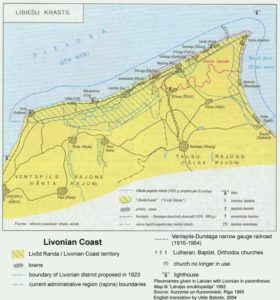
The period from 1990 to 1991 marks the transition from Soviet occupation to independence for all three Baltic countries. On May 4, 1990, the Latvian government adopted a resolution restoring the independence of the country. At the time few nations recognized this declaration. Widespread acceptance and recognition of Baltic independence would only come in late August and September of 1991 after the collapse of the failed coup in Moscow and the effective dissolution of the Soviet Union soon thereafter.
In the intervening year and a half, the Latvian government adopted a resolution, on February 4, 1991, creating a special region for the Livonians in the area of their traditional villages in northern Kurzeme. This region, given the Livonian name Līvõd Rānda (the Livonian Coast), was designated as a “national protected territory of Livonian culture and history” (valsts īpaši aizsargājamā lībiešu kultūrvēsturiskā teritorija, in Latvian). Later that year on March 19, 1991, the Livonians, along with the Latvians, were identified as the two nations indigenous to the territory of Latvia in a piece of legislation dealing with the support for the cultivation of the cultural autonomy of the nations of the Republic of Latvia. (Karma 1995: 80) (See Figure 8)
Both of these decisions were a great victory for the Livonians. At long last not only were they recognized as being partners with the Latvians in the newly restored independent Latvia, but also a region had been created for them in their traditional homeland where, ideally, a truly Livonian sense of place could be maintained and encouraged. However, in practice the true effectiveness of this region in promoting Livonian issues was limited. The main problem has remained the same as always, which is that the traditional Livonian villages are divided between two different national districts (rajons, in Latvian).
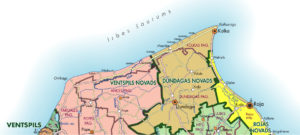
The Līvõd Rānda region ceased to exist in 2003. In the 2000s, Latvia undertook a reform of its administrative divisions. The previous two-tier system (smaller pagasts divisions within larger rajons divisions) was abolished in favor of a single-tier system in which Latvia was divided into 110 municipalities (novads, in Latvian). The earlier division of the Livonian Coast persists into the present day (See Figure 9). In the present-day administrative division of Latvia, it is still divided between two administrative divisions just as in the past. As of 2017, there is talk of further consolidation of Latvia’s administrative divisions; however, it is hard to say whether that will mean that the Livonian Coast will finally be unified as one region.
In 1992, the Livonians restarted publication of Līvli (The Livonian), the national newspaper that had been published in Livonian in Latvia during the 1930s. Also during 1992, the Livonian community began to organize its annual summer camp, intended primarily for children of Livonian descent. Held every year in Irē (Mazirbe), originally called Tšitšorlinkist (chirping birds, in Livonian), since the late 1990s it has been known as Piški Tēḑ (little star, in Livonian) (Karma 1995: 80). Piški Tēḑ refers to a poem written by Kōrli Stalte likening the Livonians to a star, remaining distinct as it shines among the myriad stars in the sky. The camp is like any summer camp, with sports and crafts activities for the children. However, in addition to this there is an hour of Livonian language instruction every day. These activities have been greatly aided by the work of modern Livonian cultural activists such as Zoja Sīle, who has administered the camp for many years, in addition to teaching Livonian at the camp and authoring learning materials for use by the children. In 2000, linguist Kersti Boiko published her book Līvõ Kēļ (Livonian language) which is a collection of Livonian language lessons for speakers of Latvian. This user-friendly and easy to understand book has been a great asset to the children at the camp and others who wish to gain a working knowledge of Livonian. In more recent years the Livonian summer camp has been called Mierlinkizt.
The 1990s also saw the election of two Livonians to the Latvian parliament, which was the first time in the nation’s history that any Livonian had held a national political office. (Karma 1995: 80) As the number of native speakers continues to dwindle, there has been a continuing and diligent effort by linguists and cultural activists to continue to perfect the orthography and publish books in Livonian. In 1998, a long held dream was realized with the publication of a bilingual Livonian-Latvian anthology of Livonian poetry, Ma Akūb Sīnda Vizzõ Tūrska! (I’m craftier than you are, cod! [the title refers to a Livonian folk song in which a fisherman is uttering this declaration to the fish he is trying to catch])
Still the 1990s leading up to the present day have also seen a continuing and predictable decline in the number of native speakers of the language, the great proportion of whom are now over 70. One rare exception is Julgī Stalte, born in the late 1970s, who in addition to being a member of the proud Stalte family, learned Livonian as a child from her grandfather. She continues to do much to popularize Livonian, not only singing in her family’s folk music ensemble (Skandinieki), but also in forming her own group, Tuļļi Lum, that released an album of contemporary Livonian music in the early 2000s. In addition to Stalte, there are also a number of fluent second-language speakers of Livonian and an enthusiastic group of learners. In 2012, the extensive Livonian-Estonian-Latvian Dictionary was published, which is also available online and contains the full description of Livonian declension and conjugation types making it an extremely useful resource for studying Livonian. As of 2017, there is also an effort by Livonian language activists on facebook to teach Livonian on the Līvõ kēļ facebook group, which shares a Livonian word each day and also provides additional information on Livonian grammar and suggestions for using Livonian in everyday life.
With the death of the last native speaker of Livonian, Grizelda Kristiņa, in 2013, Livonian encountered a turning point in its life. However, in 2017, while currently not a language of daily interaction, Livonian continues to be enthusiastically studied by Livonian descendants and others. For that reason, Livonian remains very much alive and its future is hopeful.
(This article was originally written by Uldis Balodis and published on this site in 2004, with some slight changes made to it in 2017.)
References
Auns, M. et al. 1992. Latvijas vēsture. Rīga: Zvaigzne.
Balodis, Agnis. 1991. Latvijas un latviešu tautas vēsture. Rīga: Neatkarīgā teātra “Kabata” rāmatu apgāds.
Federation of East European Family History Societies (FEEFHS). Russia, Baltics: Estonia, Latvia and Lithuania. Originally from Blackie & Sons Atlas, Edinburgh, 1882. At: http://feefhs.org/maps/ruse/re-balt.html Accessed in 2004.
Karma, Tõnu (Tenu Karma). 1994. “Lībiešu kultūras darbinieki savai jūrmalai un Latvijai.” In Lībieši, ed. Kersti Boiko. Rīga: Zinātne.
Karma, Tõnu (Tenu Karma). 1995. “Lībieši.” In Kurzeme un kurzemnieki, ed. A. Vītols. Rīga: Latvijas enciklopēdija.
Šuvcāne, Valda. 2003. Lībiešu folklora. Rīga: Jumava.
Vääri, Eduard (Eduards Vēri). 1994. “Par lībiešiem un lībiešu valodu.” (Translated from Estonian into Latvian by Tõnu Karma.) In Lībieši, ed. Kersti Boiko. Rīga: Zinātne.